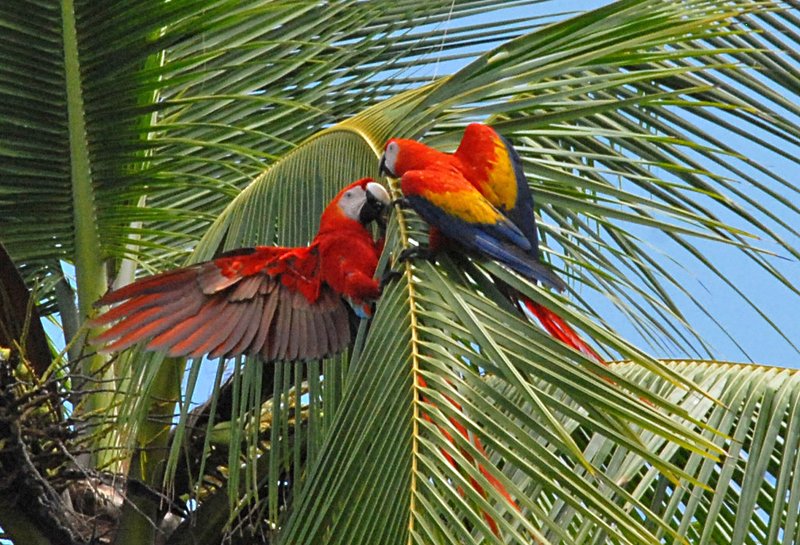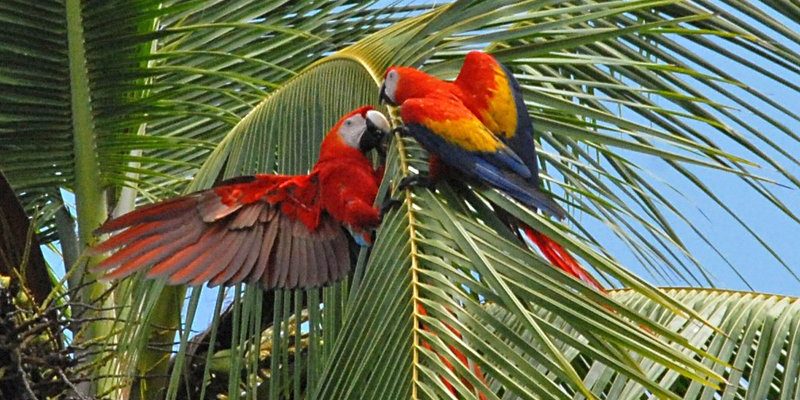
Macaws are known for their strong pair bonds, often staying together for life. Their mating dances and calls aren’t just for show; they play a crucial role in their survival and reproduction. Let’s dive into the intricate world of macaw courtship and see how these incredible birds express their affection.
The Dance of Courtship
One of the first things you’ll notice when macaws begin their courtship is the dazzling display of courtship dances. Males typically initiate this by puffing up their feathers and showcasing their vibrant colors. It’s their way of saying, “Look at me! I’m healthy and attractive!” While performing their dance, they may sway side to side or even leap between branches.
The dances also include synchronized movements with their potential mates. It’s almost like a beautifully choreographed ballet in the treetops. You might wonder why they put in so much effort. Well, these displays help the female assess the male’s fitness. The better the performance, the more attractive the male appears.
After the initial display, the pair might engage in what looks like playful chasing. It’s not just for fun—it’s a way to build their bond and establish their partnership before they commit to nesting.
Vocalizations: The Language of Love
If you thought their colors were impressive, wait until you hear their vocalizations. Macaws are known for their loud, piercing calls that can carry for miles. During courtship, these calls become even more pronounced. The males often perform a series of beautiful vocal displays to attract a mate.
You might think of this as a romantic serenade in the wild. Each species has its distinct sounds, and these vocalizations can convey messages of excitement, warning, or affection. The calls can be a way of saying, “Hey, I’m here! Let’s mate!” These vocal exchanges often lead to synchronized calling, where both the male and female echo each other’s sounds—a bonding experience that solidifies their partnership.
The importance of their vocalizations can’t be overstated. These calls help to maintain connections between the pair and also keep other competitors at bay.
Nesting Rituals: The Home-Building Process
Once a pair of macaws has formed a bond, the next step is finding a suitable nesting site. They prefer tree cavities high off the ground, providing safety from predators. This is an important phase of their courtship, as it involves teamwork.
Both the male and female play a role in preparing the nest. They might start by cleaning out the cavity or even decorating it with leaves and other materials. It’s a crucial part of their bonding process, highlighting their commitment to building a family together.
You might imagine this as a cozy little project that sets the stage for their future. Once the nest is ready, the female will lay a clutch of eggs—typically two to three. The pair then takes turns incubating the eggs, showing how cooperative they are. This shared responsibility continues even after the chicks hatch.
The Role of Color and Plumage
As we mentioned earlier, macaws are known for their brilliant colors. But did you know that their plumage plays a significant role in their courtship? The vibrant feathers are not just for show; they can indicate the health and vitality of a bird.
During courtship, males will flaunt their colorful feathers, puffing them out and turning to highlight different parts. This visual display is pivotal, as it attracts females and showcases the male’s fitness. If a male has dull or damaged feathers, it can signal poor health, which is less attractive to potential mates.
This vibrant display continues even after the mating season. The health of their feathers can affect their entire lifestyle and longevity, making it essential for both courtship and survival.
The Importance of Monogamous Bonds
Macaws are generally monogamous, meaning they mate for life. This strong, committed partnership is crucial for raising their young. Studies show that pairs who stay together typically fledge more chicks successfully than those that don’t.
This long-term bond is built through shared activities, including foraging for food, preening each other, and engaging in playful behavior. These interactions strengthen their relationship and create a nurturing environment for their offspring.
Here’s the thing: strong relationships in the animal kingdom can be just as significant as in human life. Macaws show us the beauty of loyalty and teamwork.
Challenges Facing Macaw Courtship
Despite their beautiful rituals, macaws face many challenges in the wild. Habitat loss and illegal trapping have severely impacted their populations. These threats affect their ability to find mates and raise healthy chicks.
Conservation efforts are underway to protect these magnificent birds and their natural habitats. By supporting local wildlife initiatives, we can help ensure that future generations of macaws can continue their beautiful courtship rituals.
You might be wondering how you can help. Simple actions, like supporting ethical wildlife organizations or spreading awareness about macaw conservation, can make a significant difference.
In summary, the courtship and mating rituals of macaws are a captivating blend of vibrant displays, heartfelt vocalizations, and strong partnerships. These rituals not only ensure the continuation of their species but also highlight the importance of love and loyalty in nature.
As we admire these colorful birds and their intricate behaviors, let’s appreciate the hard work involved in their courtship dances and calls. In a world where many species are threatened, understanding and supporting them can help preserve the beauty of nature for generations to come. So next time you see a macaw, take a moment to appreciate the love story unfolding right before your eyes!

